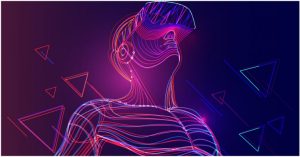There’s a promise in the possibilities and what we see and create next will stretch the imagination. A world where technology will enhance humanity by keeping people in the front, centre and in the spotlight of technology.
The spark that gives meaning to our lives is connectivity. It drives us to seek out others who feel the same way. To find those who share our views, yet offer different perspectives. Challenge us with new ways of seeing. Deepen our understanding, and enrich our lives. Great things happen, when we commit to something bigger than ourselves. The sense of collaboration, and the feelings of connection it brings, has been the foundation of every technological innovation since fire and brimstone. As we put people first, the technology fades into the background, however, it also changes the way we see the world, and in turn, changes the way we see. Over decades, the way we connect with each other has changed astronomically. From writing letters and sending Morse code to making each other laugh via stickers and emoji to satellite imaging, we have come miles ahead in the way we connect as against what we used to.
On October 29, 1969, a message was sent from a rather undisclosed room at UCLA in Southern California to a Stanford Research Institute computer console in Menlo Park, California. The system through which the message was supposed to send got crashed before accomplishing its task which was to send ‘Login”, consequently the message read ‘Lo.’ This was the world’s first message sent via an interconnected computer network known as ARPANET. This was the inception of the modern-day internet as we know it. And, since then the internet has monumentally transformed human existence and the way of connectivity.
Future of Limitless Connectivity
Imagine a world where limitless connectivity means limitless possibility. By creating connections that make the unimaginable possible, we are helping to shape an exciting and positive future. A world where limitless connectivity improves lives redefines business and pioneers a sustainable future. The time-hallowed conception of ‘everyone and everything, connected’ is the umbrella that has the potential of delivering multifarious advantages to businesses, consumers and governments as well. 5G will enable us to meet our ever-evolving expectations of dependable, pervasive and seamless connectivity. According to reports, by 2026 nearly 60% of the global population will have the access to 5G connectivity. Ericsson expects 5G subscriptions to grow to more than 3 billion, and some forecasts predict that by that time, 5G networks will carry more than 50 per cent of total mobile data traffic.
Scratching the 6G Surface
It is evident that with time, the desire to achieve faster, safer and more interacting ways of communication technology has been one of the primordial instincts of this tech-driven society and it is only going to intensify with time. 6G, the over-hyped and perhaps the most effective route could lead us to the next level of connectivity and communication. Countries are struggling to set up appropriate 5G infrastructure, and we are already anticipating the next level of communication that might be a long-standing dream to realize. 6G is in its very initial research phase as of now. We don’t know how fast 6G will be yet, but estimates have it around 100 times faster than 5G. In one of the reports circling the successor of 5G, Dr Mahyar Shirvanimoghaddam from the University of Sydney has claimed that 6G could deliver mind-boggling speeds of 1TB per second, or, 8000 gigabits per second. Long gone will be the days of downloading one movie in a few seconds from Netflix with 5G, with the 6G speed like that, you could download 142 hours of movies in just one second. Long story short, the higher speed than 5G, even Lower latency than 5G, and masses of bandwidth, that is 6G. There is more to the story, as researchers and scientists are talking about a wireless web of networks with 6G with devices acting as antennas via a decentralized network beyond the control of a single network operator. If everything connects using 5G, 6G will set these connected devices free, as higher data speeds and lower latency make instant device-to-device connection possible.
Besides the telecom spectrum, the other technologies that we anticipate to emerge with 5G like autonomous vehicles and drones to smart cities- will be enriched further with 6G. It might also quench the longstanding thirst of some to bring about the sci-fi applications like human brains and computer integration. NTT DoCoMo talks about 6G making it, “possible for cyberspace to support human thought and action in real-time through wearable devices and micro-devices mounted on the human body.” Others have called it “Teleportation of the senses” for similar reasons.
You might also like reading Is 5G still a distant hope for India?
The report points toward the realm of science fiction becoming science fact, saying speeds in excess of 100Gbps could make possible sensory interfaces that feel and look just like real life, potentially through smart glasses or contact lenses. It goes on to talk about prioritizing low power consumption for over-the-air charging, and coverage that could be extended across the sea and even out into space.
Countries across the globe are immensely investing in resources to work on 6G. As 5G is not a distant dream to achieve worldwide, most telcos and global giants have already started deployment. However, I believe 6G is the current tip of the iceberg.
Redefining Realities
According to the experts in research by Pew Research Centre in 20219, within only the next quarter-century, the way we search or use the internet will be considered “archaically clunky,” rather, our digital presence will not be separate from the physical world, but ingrained in it. Gone will be keyboards, the mouse and screens. Information will be displayed, floating in the air… not just in glass screens. The world in front of us will be a blend of reality and the virtual and, at times, it would be impossible to make sense of which one is which. Strangers will be identified as you walk past by the augmented reality lenses that everyone would be wearing, and they would present detailed information about everyone you cross paths with. Scientists and researchers are hoping to build an embedded implant technology having internet of everything that can be pre-loaded directly into our consciousness. There’s this whole idea of a brain interface. If you only have to think and it will perform [the task] for you, how much easier is it to facilitate communication?
In the near future, typing messages will go away in favour of verbal and auditory communications, much like what’s already been introduced with Apple’s Siri and Amazon’s Alexa. Instead of learning new languages, we will just install a translation app that allows us to live-translate our own speech in real-time. Communication will transform in the future. Our entire knowledge ecosystem will exist online, enabling you to understand everyone’s point-of-view regardless of who they are and where they live, whenever you want it.
You might also like reading Extended Reality, Fading the Lines between Imagination and Reality
Internet of Senses?
We play VR games today with people all over the world, get instant augmented reality translations of a foreign restaurant menu on our smartphone, meet our distant relatives over a video call, and when driving watch out for the traffic that is digitally recreated on a screen. These all come under the umbrella of extended reality (XR) using audio and video that lets us experience our physical surroundings differently and even allows us to be together with people who are physically miles apart. Looking forward to the technology development over the coming decade, it is expected that devices, sensors, and actuators as well as context-aware applications and network enablers will enable these experiences to become richer, involving all our senses, and ultimately merging the digital and the physical worlds. This experience is the Internet of Senses.
On the Internet of Senses, visual, audio, haptic, and other technologies allow human beings to have digital sensory experiences similar to the ones we experience in the physical world. The Internet of Senses augments our senses beyond the boundaries of our bodies, giving us augmented vision, hearing, touch, and smell. It enables us to blend multisensory digital experiences with our local surroundings and interact with remote people, devices, and robots as if they were right beside us.
Sensory experiences delivered over the networks are the essence of the Internet of Senses and can be demonstrated through use cases such as five senses merged reality, immersive communication, remote operation of machinery, all senses online shopping, and sustainable vacations in virtual reality.
Artificial gets real
AI will become central to our world in 2030. It will drive breakthrough innovation to improve lives and sustain our planet and become a primary source of competitive advantage for countries and businesses. We will start to see AI used across many aspects of life – from driverless vehicles to medicine, agile manufacturing, synthetic entertainment and media. There will be a world of connected, intelligent machines interacting and learning amongst themselves, while remaining accountable to human intent and ethics.
Beyond the smartphone
The arrival of increasingly sophisticated wearable technologies will create ever more seamless interactions between the physical and virtual world. For example, contact lenses that can display augmented reality content, or earbuds that can translate for you in real-time. The continued evolution of wearable technologies can also be expected that can realistically emulate a spectrum of senses – including touch, smell and sound. By the end of the decade, we may also see the arrival of the first ‘biointerfaces’ – technologies that will integrate more directly with our bodies – bringing with them new forms of communication and other possibilities for digital inclusion.
There’s a promise in the possibilities and what we see and create next will stretch the imagination. A world where technology will enhance humanity by keeping people in the front, centre and in the spotlight of technology.
Mayank Vashisht | Sub Editor | ELE Times










